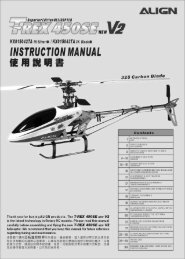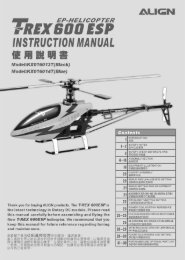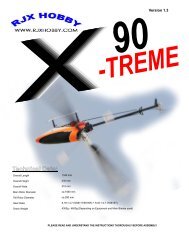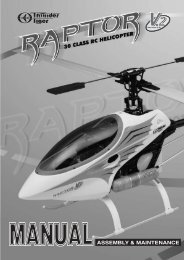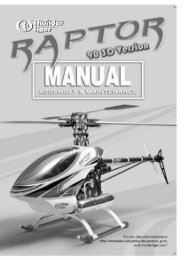DSX12 Instruction & Programming Manual - MacGregor Industries
DSX12 Instruction & Programming Manual - MacGregor Industries
DSX12 Instruction & Programming Manual - MacGregor Industries
You also want an ePaper? Increase the reach of your titles
YUMPU automatically turns print PDFs into web optimized ePapers that Google loves.
Receiver Power System RequirementsWith all radio installations it is vital that the onboard powersystem provides adequate power without interruption to thereceiver even when the system is fully loaded (servos atmaximum flight loads). This becomes especially critical withgiant-scale models that utilize multiple high torque/ highcurrent servos. Inadequate power systems that are unable toprovide the necessary minimum voltage to the receiver duringflight loads have become the number one cause of in-flightfailures. Some of the power system components that affect theability to properly deliver adequate power include: the selectedreceiver battery pack (number of cells, capacity, cell type, stateof charge), switch harness, battery leads, regulator (if used) andpower bus (if used).While JR’s receiver’s minimum operational voltage is 3.5volts, it is highly recommended the system be tested per theguidelines below to a minimum acceptable voltage of 4.8volts during ground testing. This will provide head room tocompensate for battery discharging or if the actual flight loadsare greater than the ground test loads.Recommended Power System Guidelines1. When setting up large or complex aircraft with multiple hightorque servos, it’s highly recommended that a current andvoltmeter (HAN172) be used. Plug the voltmeter in an openchannel port in the receiver and with the system on, loadthe control surfaces (apply pressure with your hand) whilemonitoring the voltage at the receiver. The voltage shouldremain above 4.8 volts even when all servos are heavilyloaded.Note: The optional Flight Log has a built-in voltmeter andit can be used to perform this test.2. With the current meter inline with the receiver battery lead,load the control surfaces (apply pressure with your hand)while monitoring the current. The maximum continuousrecommended current for a single heavy-duty servo/batterylead is three amps while short duration current spikesof up to five amps are acceptable. Consequently, if yoursystem draws more than three amps continuous or fiveamps for short durations, a single battery pack with a singleswitch harness plugged into the receiver for power willbe inadequate. It will be necessary to use multiple packswith multiple switches and multiple leads plugged into thereceiver.3. If using a regulator, it’s important the above tests are donefor an extended period of 5 minutes. When current passesthrough a regulator, heat is generated and this heat causesthe regulator to increase resistance, which in turn causeseven more heat to build up (thermal runaway). While aregulator may provide adequate power for a short duration,it’s important to test its ability over time as the regulatormay not be able to maintain voltage at significant powerlevels over time.4. For really large aircraft or complex models (for example35% and larger or jets), multiple battery packs withmultiple switch harnesses are necessary or in many casesone of the commercially available power boxes/ busses isrecommended. No matter what power systems you choose,always carry out test #1 above making sure that the receiveris constantly provided with 4.8 volts or more under allconditions.5. The latest generation of Nickel-Metal Hydride batteriesincorporates a new chemistry mandated to be moreenvironmentally friendly. These batteries when chargedwith peak detection fast chargers have tendencies to falsepeak (not fully charge) repeatedly. These include all brandsof Ni-MH batteries. If using Ni-MH packs, be especiallycautious when charging making absolutely sure that thebattery is fully charged. It is recommended to use a chargerthat can display total charge capacity. Note the numberof mAh put into a discharged pack to verify it has beencharged to full capacity.I-24




